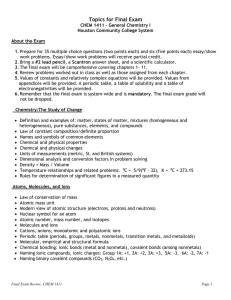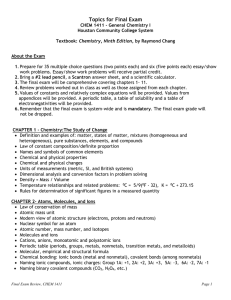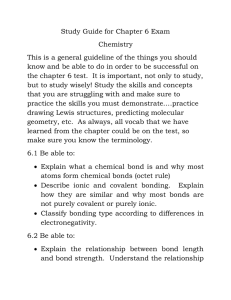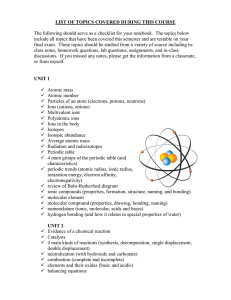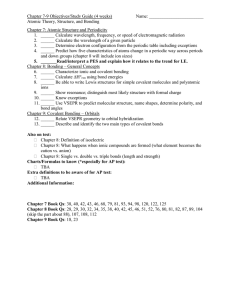1411finalreview-pahlavan.doc
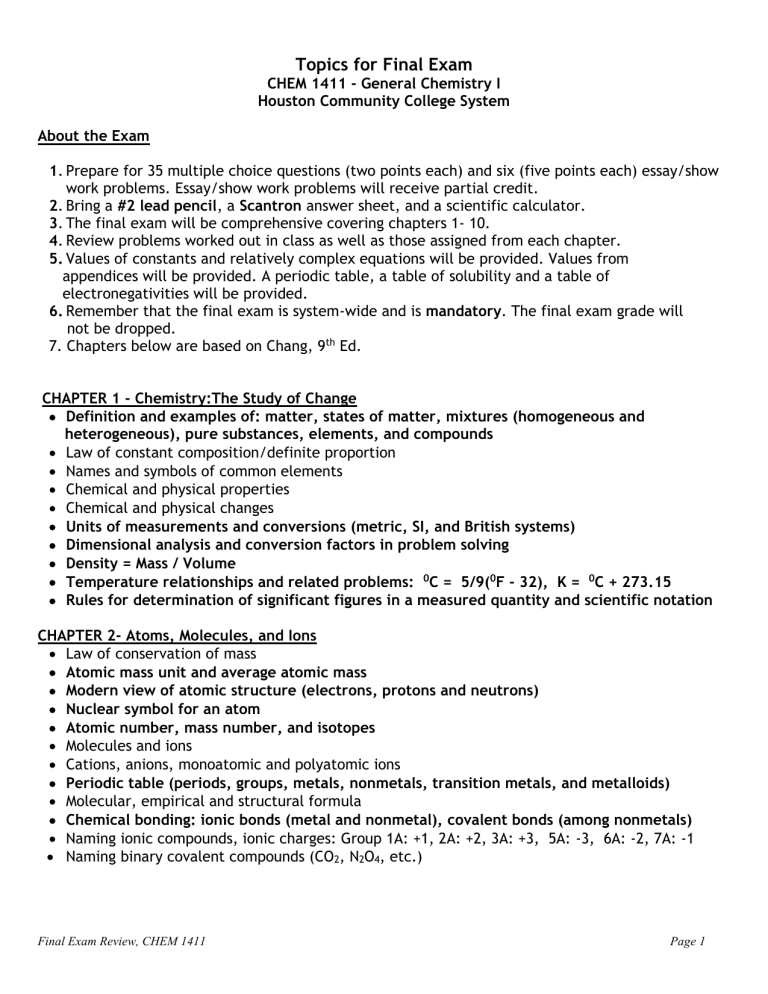
Topics for Final Exam
CHEM 1411 - General Chemistry I
Houston Community College System
About the Exam
1. Prepare for 35 multiple choice questions (two points each) and six (five points each) essay/show work problems. Essay/show work problems will receive partial credit.
2. Bring a #2 lead pencil, a Scantron answer sheet, and a scientific calculator.
3. The final exam will be comprehensive covering chapters 1- 10.
4. Review problems worked out in class as well as those assigned from each chapter.
5.
Values of constants and relatively complex equations will be provided. Values from
appendices will be provided. A periodic table, a table of solubility and a table of
electronegativities will be provided.
6.
Remember that the final exam is system-wide and is mandatory. The final exam grade will
not be dropped.
7. Chapters below are based on Chang, 9 th Ed.
CHAPTER 1 - Chemistry:The Study of Change
Definition and examples of: matter, states of matter, mixtures (homogeneous and
heterogeneous), pure substances, elements, and compounds
Law of constant composition/definite proportion
Names and symbols of common elements
Chemical and physical properties
Chemical and physical changes
Units of measurements and conversions (metric, SI, and British systems)
Dimensional analysis and conversion factors in problem solving
Density = Mass / Volume
Temperature relationships and related problems: 0 C = 5/9( 0 F - 32), K = 0 C + 273.15
Rules for determination of significant figures in a measured quantity and scientific notation
CHAPTER 2- Atoms, Molecules, and Ions
Law of conservation of mass
Atomic mass unit and average atomic mass
Modern view of atomic structure (electrons, protons and neutrons)
Nuclear symbol for an atom
Atomic number, mass number, and isotopes
Molecules and ions
Cations, anions, monoatomic and polyatomic ions
Periodic table (periods, groups, metals, nonmetals, transition metals, and metalloids)
Molecular, empirical and structural formula
Chemical bonding: ionic bonds (metal and nonmetal), covalent bonds (among nonmetals)
Naming ionic compounds, ionic charges: Group 1A: +1, 2A: +2, 3A: +3, 5A: -3, 6A: -2, 7A: -1
Naming binary covalent compounds (CO
2
, N
2
O
4
, etc.)
Final Exam Review, CHEM 1411 Page 1
CHAPTER 3 – Mass Relationships in Chemical Reactions
Balancing chemical equations
Determination of average atomic mass (atomic weight) with isotopic distribution
Calculation of formula weight (molar mass)
The mole and related problems (Avogadro’s number = 6.022 x 10 23 )
Calculation of percent composition
Calculation of empirical formula and molecular formula from the percent composition
Calculations based on the stoichiometry of chemical equations including limiting reactant,
theoretical yield and percent yield
CHAPTER 4 – Reactions in Aqueous Solutions
Electrolytes (classification and example)
Acids, bases, and salts (definition, classifications and examples)
Double displacement and metathesis reactions (definitions and writing formula, ionic and net ionic equations)
Solubility tables and net ionic equations
Oxidation and reduction ("redox") reactions
Single displacement reactions and the activity series
Oxidation numbers of an element in a compound
Solution concentration: Molarity = moles of solute per liter of solution; M = moles/L
Dilution (V
1
M
1
= V
2
M
2
)
Titrations and related problems, mL
A
M
A n
H
+ = mL
B
M
B n
OH–
CHAPTER 5 - Gases
Kinetic-Molecular Theory
Atmospheric pressure, units of pressure (atm, mm Hg or torr, Pa)
Gas laws: Boyle’s law, Charles’s law, Avogadro’s law, Ideal-Gas equation, Gas densities and
molar mass, Dalton’s law of partial pressure, Graham’s law of effusion and diffusion
Definition of STP conditions
At STP, one mole of any ideal gas occupies 22.414 L
Deviations from ideal behavior
Stoichiometry problems involving gases
CHAPTER 6 - Thermochemistry
Definition of energy, kinetic energy and potential energy
Units, joules and calories, 1 cal = 4.184 J
First law of Thermodynamics
Internal energy (E), E = q + w
State functions
Enthalpy (H), H = q at constant pressure, exothermic processes (negative H value) and
endothermic processes (positive H value)
Hess’s law and related problems
Specific heat and heat capacity
H = q = specific heat x grams of substance x T
Heat = heat capacity x T
Calorimetry, problems dealing with coffee-cup and bomb calorimeter
Calculating enthalpies of reactions using enthalpies of formation ( H f o )
Final Exam Review, CHEM 1411 Page 2
CHAPTER 7 – Quantum Theory and the Electronic Structure of Atoms
Electromagnetic radiation
c = wavelength x frequency (c = λν )
Relationship between the energy of radiation and its frequency or wavelength
Planck’s quantum theory, E = h ν
Photoelectric effect and the photon
Bohr’s model of the hydrogen atom
Principal quantum number n, E
Electronic transitions, E = R n
= –R
H
(1/ n 2 ), n = 1, 2, 3, . . .
H
(1/n i
2 – 1/n f
2 )
Wave functions and electron density
Quantum mechanical description of orbitals, their shapes and energies
Shells (energy levels) and subshells (sublevels)
Four quantum numbers (n, l , m l
, m s
)
Pauli exclusion principle, Aufbau principle, and Hund’s rule
Electron configuration in ground state
CHAPTER 8 – Periodic Relationships Among the Elements
Atomic sizes, ionization energies and electron affinities trends
Effective nuclear charge, Z eff
The periodic table, groups and periods, ions and isoelectronic series
Physical and chemical properties of metals, nonmetals, and metalloids
Overview of chemistry of the representative elements (Groups 1A–8A)
CHAPTER 9 – Chemical Bonding I: Basic Concepts
Ionic bonding, lattice energy, ionic sizes (cations, anions, and isoelectronic ions)
Covalent bonding, Lewis dot structures, the octet rule, formal charges, and resonance
Exception to octet rule, less than an octet (e.g., BF
3
), "expanded octet" (e.g., PF
5
, SF
6
)
Bond dissociation energy and related problems
Electronegativity
Polar and nonpolar covalent bonds
CHAPTER 10 – Chemical Bonding II: Molecular Geometry and Hybridization of Atomic Orbitals
Molecular shape, bond angle and bond length
The VSEPR model
Electron domain (or “electron pair") geometry
Molecular geometry
Polarity in molecules; dipole moment
Valence-bond theory, sigma and pi bonds
Hybrid orbitals (sp, sp 3 , sp 3 d, sp 2 , sp 3 d 2 )
Molecular orbital (MO) description of covalent bonding
Molecular orbital energy level diagrams
Bond order, diamagnetic and paramagnetic molecules
Final Exam Review, CHEM 1411 Page 3
CHAPTER 11- Intermolecular Forces and Liquids and Solids
Characteristic properties of the three states of matter
Intermolecular forces: ion-dipole forces, dipole-dipole forces, London dispersion forces, and
hydrogen bonding
Phase changes and dynamic equilibrium
Properties of liquids: vapor pressure, volatility, boiling point, surface tension, and viscosity
Phase diagrams
Heat of fusion and heat of vaporization
The Clausius-Clapeyron equation
Heating curves and related calculations
Structures of solids: crystalline vs. amorphous solids
Unit cells (primitive cubic, body-centered cubic, face-centered cubic)
Calculating the density of a solid from the type of unit cell and the unit cell dimensions
Final Exam Review, CHEM 1411 Page 4
